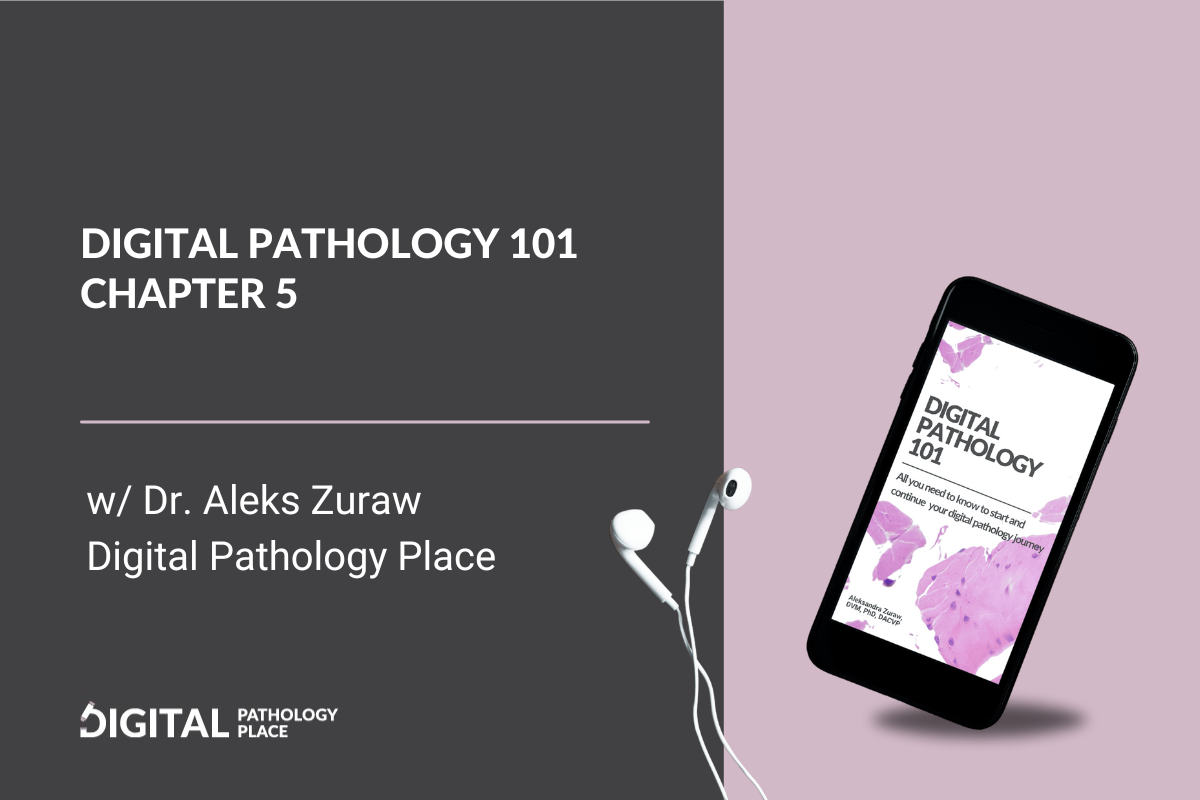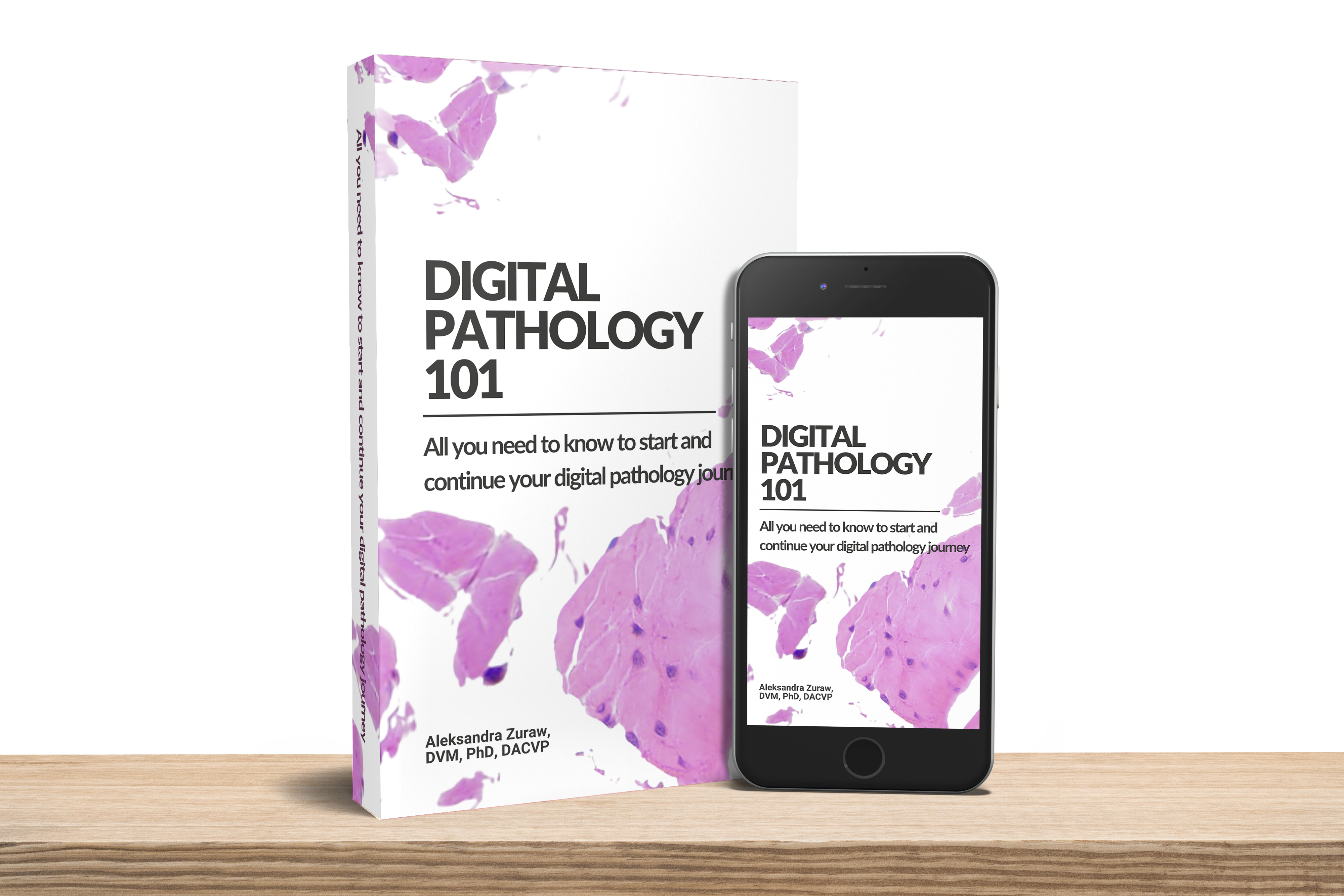Digital Pathology 101 Chapter 5 | The Role of Whole Slide Imaging in Toxicologic Pathology

Digital Pathology 101 Chapter 5 | The Role of Whole Slide Imaging in Toxicologic Pathology
Toxicologic pathology plays a critical role in drug development, yet its intersection with digital pathology is often overlooked. As a veterinary pathologist, I want to shed light on this important application.
This is Chapter 5 of the “Digital Pathology 101” book and in this chapter, you will learn how whole slide imaging is transforming preclinical trials. I’ll explain key concepts like creating faithful digital replicas of glass slides. We’ll also dive into validations needs for digital systems in regulated GLP studies.
Whole Slide Imaging Overview
I’ll start by explaining whole slide imaging. This technology creates 2D digital copies of glass slides. The focus is not 3D images, but flat digital images containing the visual information pathologists need for analysis and reporting.
The FDA states these digital images can substitute for glass slides in preclinical toxicity studies, provided they meet requirements as “faithful digital replicas.” With proper validations, digital slides enable remote assessments for multisite trials.
Validation and Documentation
For regulated GLP studies, replacing glass slides necessitates validating the whole digital pathology system. This includes IT infrastructure, scanners, software and more based on intended use.
Documentation is also key. Peer review statements should note the use of digital slides. Images must be securely stored and transmitted to maintain raw data integrity.
Conclusion
In closing, the FDA’s guidance on digital pathology in preclinical trials signals an important step towards regulatory acceptance. Digital tools promise more controlled, efficient toxicity assessments, ultimately advancing drug development.
This chapter provides a compass for teams navigating digital pathology in regulated environments. Understanding principles of validation, security, and transparency allows us to realize the benefits while ensuring high standards.
You can find the original FDA guidance document this chapter is based on here:
Or you can watch me explain the guidelines here:
Get the PDF of “Digital Pathology 101” Book here
Get the paper copy of “Digital Pathology 101” on AMAZON
Become a Digital Pathology Trailblazer and See you inside the club: Digital Pathology Club Membership
watch on YouTube
DIGITAL PATHOLOGY RESOURCES
transcript
CHAPTER 5: THE ROLE OF WHOLE SLIDE IMAGING IN TOXICOLOGIC PATHOLOGY
I. Introduction
A. Digital Pathology and Toxicologic Pathology: An Overlooked Alliance
As a veterinary pathologist working in the field of toxicologic pathology, I’ve realized that the wider pathology community is often unaware of the role of veterinary pathologists in the drug development process. So, with a nod to my profession, I’ve dedicated this chapter to digital pathology topics relevant to non-clinical pathology, specifically toxicologic pathology.
This chapter will serve as a source of information about the role of digital pathology in the non-clinical space and about the regulatory framework used to guide this space.
B. Importance of WSI in Toxicologic Pathology
Recent advancements in digital pathology have significantly enhanced the application of whole slide imaging within the field of toxicologic pathology. The ability to digitize glass slides and the potential this technology offers is viewed as a pivotal transformation in drug discovery and preclinical drug development work.
C. The FDA Guidance Document for WSI in Non-clinical Pathology
Recognizing the importance of standardization in this growing field, the FDA has provided a guidance document to outline the usage of WSI within non-clinical pathology, particularly in the realm of toxicology. This document intends to guide industry practices and encourage compliance with Good Laboratory Practice (GLP) regulations.
II. Whole Slide Imaging (WSI)
A. The Concept of WSI
WSI involves the digitization of glass slides to create two-dimensional digital images. It is important to clarify that the focus of this technology is not the creation of 3D or dynamic zoom images, but rather flat, two-dimensional images.
B. The Role of WSI in Generating Pathology Reports
These images are critical for routine assessments, as they contain the information necessary for the pathologist to generate pathology reports, which are key data components in non-clinical, preclinical toxicologic pathology, adhering to GLP regulations.
C. The Quality and Faithfulness of Digital Replicas
Although WSI does not yield an exact copy of the glass slide due to inherent scanning limitations, the FDA assures that when WSIs include all the elements from glass slides needed for histopathological evaluation they are adequate for pathology report generation. In that case they are referred to as “faithful digital replicas”.
III. WSI Retention
For GLP compliant studies, if digital slides are assessed in lieu of glass slides the FDA mandates the preservation of digital slides post-use, mirroring the conventional practice of retaining glass slides. This requirement enables data traceability and facilitates information retrieval, both crucial for the review process.
IV. Whole Slide Imaging System Validation
If WSI substitutes original glass slides for GLP studies, the FDA necessitates system validation. This rule extends to digital pathology systems, which are classified as computerized systems.
Digital pathology systems comprise:
● the IT infrastructure,
● whole slide scanner – image acquisition system,
● image analysis software,
● and potentially annotation software.
In the USA these systems are regulated by the Code of Federal Regulations, Title 21, Part 11 Electronic records, Electronic signatures, and associated predicate rules related to the GLP, including 21 CFR part 58. Part 11 pertains to electronic records and signatures, and part 58 addresses the nonclinical aspect of drug development and toxicology.
When validating a digital pathology system, the intended use should be defined, which could range from:
● generating illustrative images,
● conducting pathology consultations,
● facilitating telepathology, ● assisting diagnosis,
● to performing primary histopathological evaluation
Depending on the intended use, the stringency or number of features to check and validate will vary.
The process of validation is a collaborative effort involving:
● pathologists,
● IT,
● quality assurance,
● and system owners.
Representatives from each of these teams should participate in the validation process.
V. Electronic File Protection and Transmission
If whole slide images are the source of raw data, they need to be safeguarded against any data loss or modification. Measures to uphold the chain of custody, restrict access, and ensure the security of data systems and data transmission should be in place. These measures should align with written procedures and processes that comply with the stipulations for electronic records under 21 CFR part 11, to ensure the integrity of the whole slide image files is maintained.
VI. Documentation of Digital Pathology Use in Pathology Report
The FDA emphasizes the importance of documentation within the pathology report, inclusive of a peer review statement if WSI replaces glass slides. This level of transparency guarantees that every process step is traceable and verifiable.
VII. Conclusion
The FDA’s guidance on WSI utilization in toxicologic pathology signifies a major stride towards regulatory acceptance of digital pathology in the non-clinical drug development support. It also means a more controlled, reliable, and efficient assessment of preclinical trials, maximizing the benefits of emerging digital pathology technologies. As with all regulatory documents, this guidance is anticipated to evolve in line with field advancements, thereby ensuring that the practices continue to promote the best interests of the industry and the wider public. In conclusion, digital pathology is a fascinating field requiring team effort to validate and develop. By understanding its regulation, validation strategies, principles, and terminology, we can contribute to its growth and development.
related contents
- Remote toxicologic pathology. How Deciphex is accelerating the non-clinical drug development phase w/ Donal O’Shea
- What does the FDA say about non-clinical digital pathology for GLP?
- Telepathology in Time of Coronavirus
- Welcome
- Digital Pathology 101 Chapter 4 | Digital Pathology Applications
- What Is the Role of Digital Pathology in Clinical Trials w/ Monika Lamba Saini
- The Regulatory Aspect of Digital Pathology and Translational Medicine w/ Esther Abels













